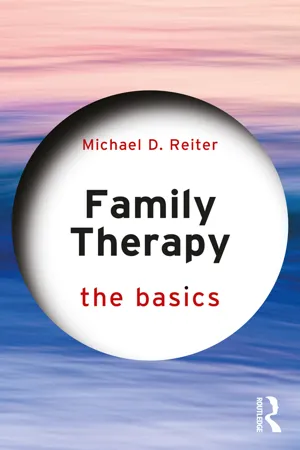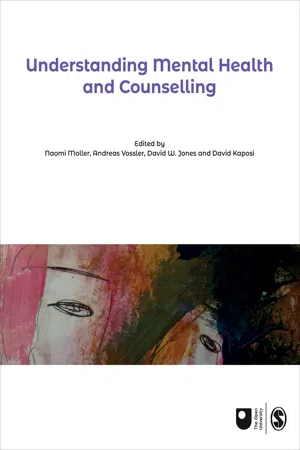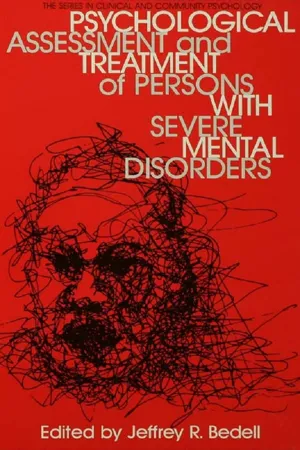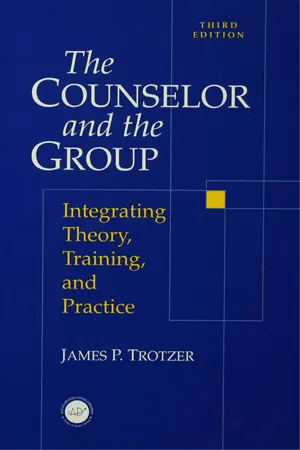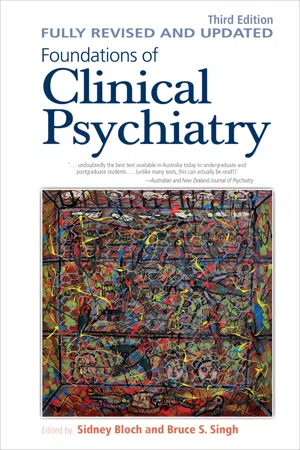Psychology
Group and Family Therapy
Group and family therapy involve therapeutic interventions that focus on the dynamics and interactions within a group or family unit. These approaches aim to address relational issues, improve communication, and foster understanding among members. Group therapy typically involves a small group of individuals, while family therapy involves the entire family system, with the goal of promoting healing and growth within the group.
Written by Perlego with AI-assistance
Related key terms
Related key terms
1 of 4
Related key terms
1 of 3
9 Key excerpts on "Group and Family Therapy"
- Holly Crisp, Glen O. Gabbard(Authors)
- 2022(Publication Date)
- American Psychiatric Association Publishing(Publisher)
McRae and Short 2009 ).Social Context for Understanding and Change
“We can help each other to understand and change ourselves.”Some therapy groups make use of the social context and balance focusing on the individual member and focusing on the group as a whole. An example of this approach is called group analysis (Foulkes and Anthony 1957/2014 ), which combines psychoanalytic insights with an understanding of social and interpersonal functioning. Group analysis is the most commonly used psychodynamic approach to group psychotherapy outside the United States and Canada.In this approach, the group-as-a-whole (see section “Core Concepts in Group Psychology”) is viewed as an entity worthy of explicit focus alongside each member. The group therapist, called the conductor , contributes fewer explicit verbal interpretations and aims to address individual concerns through exploration of the dynamics of the group as a whole and each member’s relationship to it, embedded in the larger social milieu and shaped by both conscious and unconscious forces. Many other theoretical and practice considerations have been developed in this rich method (Schlapobersky 2016 ).Giving and Receiving Peer Interpersonal Feedback
“I can understand others. I can understand myself.”Some therapy groups focus on the content and dynamics of interpersonal exchange (Leszcz 1992- eBook - ePub
Family Therapy
The Basics
- Michael D. Reiter(Author)
- 2023(Publication Date)
- Routledge(Publisher)
Nuclear family: The family that one lives in, usually consisting of the parents and children.- Postmodernism: The idea that there is no reality, but that we construct reality based on socially agreeing on what is.
- Professional association: A group of people in a field who network together to discuss the best practices and ethical guidelines for that profession.
- Reflecting team: A group of therapists who watch a family session and then discuss what they watched as the family observes them.
Chapter Summary
- Family therapy was primarily developed in the 1950s.
- Family therapy focuses on the family as a unit.
- The history of family therapy was born out of work with schizophrenics.
- The 1960s and 1970s saw a proliferation of many different models of family therapy.
- The latter part of the 20th century saw an increased focus on the notion of postmodernism, where family therapists moved away from absolute truth.
- Family therapists engage in many of the same activities as other helping professions, yet their view of the problem focuses more on what happens between people rather than within a person.
- Family therapy is a regulated field. Family therapists must be licensed and need education, supervision, and clinical hours to become licensed.
Reference
- Bateson, G., Jackson, D. D., Haley, J., & Weakland, J. (1956). Toward a theory of schizophrenia. Behavioral Sciences, 1
- eBook - ePub
- Naomi Moller, Andreas Vossler, David W Jones, David Kaposi, Naomi Moller, Andreas Vossler, David W Jones, David Kaposi(Authors)
- 2020(Publication Date)
- SAGE Publications Ltd(Publisher)
et al., 2018).All CBT group programmes use similar methods (e.g. psychoeducation, cognitive restructuring and graded exposure – see Chapter 10 for a reminder of the definition of the latter) and usually follow a preset manual. CBT group therapists typically play a more active role in guiding the group through each session. Recently, there has been more focus on the importance of group processes and structure, and how practitioners can manage these aspects of group practice more effectively to improve outcomes. Mental health service providers have recognised the benefits and often greater efficiency (Morrison, 2001) of therapeutic groups, which are now an indispensable and essential part of, for example, the UK’s NHS services for mental health problems.Pause for reflection Imagine, as a practitioner, you want to invite a client to attend group therapy instead of individual therapy. What would you say to motivate them to choose this intervention?Conclusion
This chapter has covered the evolution of systemic therapy and group therapy and the ways they have widened the traditional therapeutic focus on the individual. Systemic principles and techniques have been introduced that can help practitioners to look beyond the individual to understand clients and their problems within the various contextual layers in which they are embedded (from family relationships to wider society). The chapter has argued that clients can benefit from a range of universal processes specific to therapeutic group work, and from the specific therapeutic factors offered in this setting (e.g. positive peer modelling and peer support). Group interventions range from psychodynamic group therapy to therapeutic programmes offered to people with similar problems (e.g. mindfulness and psychoeducational groups) and self-help groups that follow a set of principles in supporting each other (e.g. Alcoholics Anonymous’ 12-step programme). Research has provided evidence for the benefits of both therapeutic group work and systemic family therapy, although more attention needs to be given to the specific processes and factors at work in group and family settings. - eBook - ePub
Voices From the Field
Group Work Responds
- Albert S Alissi, Catherine C Mergins(Authors)
- 2013(Publication Date)
- Routledge(Publisher)
Interactions between families are viewed as opportunities to obtain information and feedback in order to bring about change within individual family units. Change within families is precipitated through the process of presenting themselves as families to others. An individual familys' child management practices, organization, and beliefs become the focus of discussion within the larger group as well as being evaluated within the family. Furthermore, the practice portion of each group attempts to bring about family change, which then has an effect on the larger group. Children's behavior is viewed as being altered by shifts in the relationship that they have with parents, brought about by both interactions with other families and the development of more positive family interactional patterns. The theoretical model in Figure 7.1 attempts to highlight the process of change that guided the development of the multiple-family group. The progression of clinical work within MFTGs has been discussed as consisting of sequential phases: a beginning, middle, and ending phase. Decisions as to the inclusion of members mark the beginning of the first phase of treatment. Criteria for inclusion include those families that can benefit from education around a particular problem. Families that need to address social isolation, division of family role responsibilities, or lifestyle transitions should be considered for multiple family therapy groups (Cassano, 1989a). For this particular group, families were recruited through their primary therapists. It was open to families with at least one school-age child. All family members and significant relatives/others in the household were invited to attend. Families with extreme safety concerns (e.g., current child abuse/neglect or active suicidal ideation) were excluded. Caretakers presented a range of concerns about their children prior to beginning the group - Jeffrey R. Bedell(Author)
- 2013(Publication Date)
- Taylor & Francis(Publisher)
Part Three Group and Family Therapy inRehabilitationPassage contains an image Chapter 10 Behavioral Group Therapy in Rehabilitation Settings
Dennis Upper and John V. FlowersAn important development in psychiatric rehabilitation has been the increasing use of behavioral group therapy techniques, which combine psychological and educational methods to change behavior and to teach a variety of adaptive skills. The term “behavioral group therapy” has had three primary definitions during the course of development of this field. In its first (and most common) meaning, behavioral group therapy refers to the application in a group setting of behavior change techniques that initially were developed in individual therapy, such as systematic desensitization. When defined in this way, behavioral group therapy usually is directive, interpretive, and focused on the behaviors of individual group members. Goldstein, Heller, and Sechrest (1966) have referred to this as the process of doing behavior therapy in groups, as opposed to doing it through groups.A second meaning of behavioral group therapy has been the use of specific behavioral interventions within an existing therapy group, regardless of the therapeutic orientation being used. Usually, one behavioral intervention (such as conditioning against silence or reinforcing the use of “I” statements) is used, and all of the other interventions are not specifically behavioral. Although this therapy is done through groups, it is not really behavioral group therapy. Instead, it is some form of traditional group therapy that is made potentially more effective by the limited use of behavioral principles.A third type of behavioral group therapy, which does not fully exist at present but is still emerging and developing, involves both applying behavioral techniques in a group setting in the most effective and cost-efficient manner and attempting to enhance therapeutic outcome by manipulating group-process variables in some planned ways. In this case, the patients, problems may be homogeneous or heterogeneous, but the interventions are specific and systematic, matched to the problems of the individual patients, executed by the entire group, and based on learning principles (Flowers, 1979).- eBook - ePub
Counselor and The Group
Integrating Theory, Training, and Practice
- James P. Trotzer(Author)
- 2013(Publication Date)
- Taylor & Francis(Publisher)
The focus of group counseling is on problems. It is oriented toward helping members express and explore their difficulties and concerns in an effort to use the group’s resources to find ways of overcoming these difficulties and living more fulfilled and satisfying lives. This integration of process and purpose is a prominent element in our definition. Process involves two basic phases. The first is characterized by relationship development that leads to self-disclosure and understanding of one’s problems, the second is associated with action directed toward resolving the problems. During the action phase the client uses the group to help him or her discover alternatives, evaluate their implications and probabilities of success, and then practice and implement them to solve the problem. Thus the purpose of group counseling is to deal directly with a client’s difficulties, stresses, frustrations, problems, concerns, and dissatisfactions in an effort to remove them as factors impeding the client’s growth, development, and personal fulfillment. The unique aspect of group counseling is the “helping each other” process, which will be discussed in greater depth a little later in this chapter. The group counseling definition in total is:Group counseling is the development of an interpersonal network characterized by trust, acceptance, respect, warmth, communication and understanding through which a counselor and several clients come in contact in order to help each other confront unsatisfactory or problem areas in the clients’ lives and discover, understand and implement ways of resolving those problems and dissatisfactions (Trotzer, 1972 ).This definition differentiates counseling or therapy groups from other group experiences or interactions based on the mobilization of interpersonal human resource potential in relation to a helping objective. Several key points are emphasized. As an interpersonal network the counseling group represents a human process reflective of the domain of human relationships in which members are experiencing their problems.Second, the traits of that therapeutic network only have meaning in a relational context. Trust, acceptance, respect, warmth, communication, and understanding can only be experienced if interpersonal relationships are present. Third, there is a built-in interpersonal growth dynamic in that the process depends on members helping each other. And finally, the focus and purpose of the group are explicit. Counseling groups are initiated for the purpose of problem solving. As such the counseling group represents a temporary interventive modality in each group member’s life, the therapeutic impact and duration of which is governed by the intention on the part of both leaders and members to dissolve the group by resolving the problems (Trotzer, 1985 - eBook - ePub
- Sidney Bloch, Bruce S. Singh(Authors)
- 2013(Publication Date)
- Melbourne University Press Digital(Publisher)
The process of self-help groups varies, but prominent features are: mutual support, a shared commitment to keep going whatever the odds (e.g. even if a member has resumed drinking) and encouragement to lead as a normal life as possible.A robust self-help movement is an invaluable complement to any contribution made by the mental health professions. We need to remind ourselves to respect the expertise of patients and their families which is attained by direct experience.Family therapy
That naturally occurring social group, the family (nuclear or extended), may be the most appropriate context for therapy. Medicine has tended to focus on the individual, although we have appreciated that family factors may influence the onset and outcome of illness. The family has been seen as: (a) a possible cause (e.g. genetic or psychogenic); (b) a source of information about the patient; (c) a potential support to the patient, both emotionally and practically; and (d) an ally in monitoring co-operation with treatment and noting deterioration. In addition, family therapy has developed as a treatment to change family function. While drawing on, inter alia, cognitive, behavioural and psychoanalytic concepts, it also incorporates those devised by family therapists themselves.Psychological principles were not applied to families until the 1950s when Nathan Ackerman coined the term ‘family therapy’. Salvador Minuchin worked with delinquent ghetto youth whose behaviour resisted conventional psychotherapy. He observed improvement when an underfunctioning parent was recruited into the therapy and encouraged to devise fresh ways of responding to the child. He then worked with families with an adolescent suffering from anorexia nervosa or brittle diabetes and noted tension between the parents and maladaptive coalitions between a parent and the child. The child could be understood as carrying the family’s unspoken conflicts and anxieties. Emerging from the work came the distinction between problem causation and problem maintenance and viewing it as a feature of systems thinking (see below).Systems thinking
Any system (e.g. biological, family, social) is more than the sum of its parts because of the ways the parts interact. Thus, the conventional linear view of causality (A causes B) is replaced by the notion of reciprocal patterns (A causes B causes A causes B, and so on). This feedback regulation was first noted as the means by which physiological systems (e.g. the endocrine system) maintain equilibrium. - eBook - ePub
Self Experiences in Group, Revisited
Affective Attachments, Intersubjective Regulations, and Human Understanding
- Irene Harwood, Walter Stone, Malcolm Pines(Authors)
- 2012(Publication Date)
- Routledge(Publisher)
Relationship-focused group therapy is conceived by the authors (Feldman & Kahn, 2009 ; Kahn & Feldman, 2007) as separate psychodynamic therapy for each of the partners, if possible in conjunction with ongoing couples therapy. Group therapy is basically a psychodynamic process in which imitation, identification, and internalization are considered primary therapeutic processes (Rutan & Stone, 1993). RFGT is based on principles of self psychology, interpersonal group therapy, and object relations theory, and integrates techniques from imago relationship therapy such as the couples dialogue (Hendrix, 1988 ; Hendrix & Hunt, 2004). It is a treatment opportunity to work on couples dynamics within a group setting. The thesis is that the ability to metabolize, contain, and empathize leads to safety and mutual growth. However, in less well-functioning couples there are often instances in which growth may be inhibited by the presence of the partner. In these instances, growth may best occur when an opportunity is presented for each partner to work through the marital gridlock difficulties in a safe, separate, relationship-focused group process. Safety in the therapy group occurs when a group member finds at least one (hopefully more) person in the group who “gets” them, who is understanding and supportive of them. This person is seen as their emotional “twin” and aids in their feelings of connection and safety in the group Harwood (1966). Another important aspect of relationship-focused group therapy is finding someone in the group who is seen as a twin for their partner. Almost invariably, the group members find one or more people in the group who resembles the partner and then displace the feelings from the partner onto the partner’s twin (Livingston, 2004) - eBook - ePub
The Silent Language of Psychotherapy
Social Reinforcement of Unconscious Processes
- William Zimmerman(Author)
- 2017(Publication Date)
- Routledge(Publisher)
The concepts of “completing one’s analysis,” of “being cured,” of “mastering one’s own problems” are based on the idea that there is a state of optimum mental health that can be reached. This state is sometimes defined as one that permits the individual to have self-correcting devices at his disposal—methods of recognizing problems and making adequate corrections. In view of these definitions of the state of mental health, one might believe that help should be needed only temporarily or until the patient has succeeded in establishing these self-correcting attitudes. This view of mental health, however, is highly doubtful. Most individuals cannot be categorized as being either “self-actualized” or “self-correcting” or, on the other hand, as “sick” or “not self-correcting.” The chances are that a vast majority of people are self-correcting with regard to some of their problems, while they are constricted in others. In our experience, even the adequate and healthy person can profit from engaging in a therapeutic relationship, from looking at the self and discovering personal responses in the presence of another person, and from inspecting personal patterns of automatic behaviors and constrictions. Not everyone may need psychotherapy, but everyone can, nevertheless, occasionally profit from the experience.Continuous contact of many years’ duration, even though some years may entail attendance at only a few meetings with a therapist, seems particularly profitable as a preventive measure. In fact, the field is slowly moving away from exclusive occupation with disturbed individuals or people in great pain, and much therapeutic work today includes seeing normal individuals who present specific problems, such as stress-reduction. These individuals have problems in mind when they begin therapy, but are also essentially interested in developing their resources and their potential. At this point we refer to a remarkable book that has summarized hundreds of researches in the area of group therapy and group treatment: Meltzoff and Kornreich (1970). In this book are reports of research on most of the questions that people want to ask about group therapy and group leadership, and even some questions that we do not particularly wish to ask. Yet even these studies do not include research on very large audiences.The present focus on biological health is no longer exclusively concerned with sanitation, nutrition, and medicine: changes in a person’s life-style, including emotional style of life, are included as an essential element to achieving well-being. The question of how a large number of people can be helped to affect such changes is a vital research question.
Index pages curate the most relevant extracts from our library of academic textbooks. They’ve been created using an in-house natural language model (NLM), each adding context and meaning to key research topics.
Explore more topic indexes
Explore more topic indexes
1 of 6
Explore more topic indexes
1 of 4

